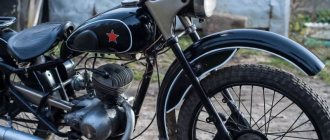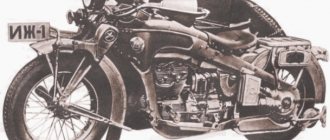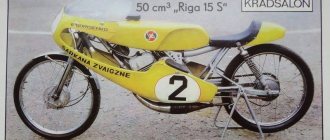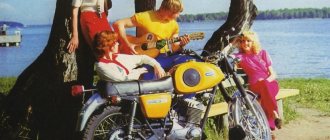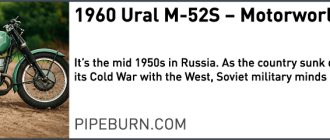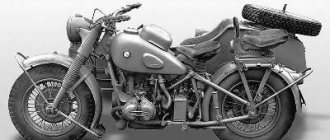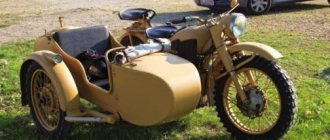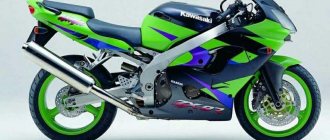Author: Oleg
02 June 2015 14:37
Tags: car motorcycle sidecar motorcycle
14092
11
Motorcycles with sidecars, in demand in the middle of the last century, are turning into rarities. They are becoming less and less common on our roads, giving way to more modern means of transportation.
0
See all photos in the gallery
However, this type of transport still exists, enjoying steady demand among residents of rural areas, extreme sports enthusiasts and originals. The latter continue to persist in the opinion that a motorcycle with a sidecar is incredibly cool. And not only in matters of transporting hay and potatoes. By the way, we sincerely believe that the coolest motorcycles with a sidecar are the Ural. Honestly, without any advertising and simply because their design is not outdated, but has turned into a very interesting vintage. Not to mention the hidden off-road power. But today we will look at completely different motorcycles with a sidecar.
City
When driving in the city, in dense traffic of cars and other vehicles, try to avoid unnecessary lane changes, and even more so “playing tag.” The rather sharp handling of a wheelchair user, in principle, allows this to be done, but this aggressive driving style, firstly, irritates surrounding drivers, and secondly, creates emergency situations, if only because the motorcyclist may not have time to react to a suddenly appearing obstacle, and high mass and brakes that are more inert than those of a single person can only aggravate the consequences. It is best to drive in the far right lane, especially on roads where there is no special lane for route vehicles. As practice shows, this is the safest way to travel around a big city with wide roads. However, just in case, do not forget to visually “scan” the space to the right and right-behind of your wheelchair user; a scooter rider can suddenly and unpredictably jump out of there, and even a cyclist in slow-moving traffic. Always look through this space when turning right for the same reason (and the author would give this recommendation to any driver at all, since he himself sometimes rides a scooter where the traffic rules are prescribed - to the right of the entire flow and no further than 1 meter from the edge of the roadway, and often barely had time to brake in front of cars whose drivers do not consider it necessary to take the extreme right position on the roadway when turning right).
Winter. “Kolyasych”, triumphant...
Driving in winter is a rather controversial issue. The author, in addition to winter “rides” in a wheelchair, also has experience of driving all winter long, but explains this by youth and recklessness: there is certainly no comfort, and even the degree of danger increases significantly. Naturally, everyone decides for themselves whether to travel in winter or not, whether to go out for a ride or stay at home, but there are still some commonly used tips. Warm yourself! If on foot at -5 you are used to walking without a hat with your collar wide open, then before the trip put on twice as much clothing as would be useful in twenty-degree frost. Yes, it hinders your movement, yes, it’s hot for you to get to the motorcycle and start it, but when riding, the cooling conditions for your body are completely different. Your task is to avoid hypothermia and frostbite. Warm up the engine. Let it sit and thresh at idle longer - it won’t overheat, but it will cool down properly after a kilometer. Reduce your overall movement speed relative to summer speed. Maneuver as carefully as possible. Even if you drive on dry asphalt in cold weather, the likelihood of skidding is significantly higher than on wet asphalt in summer.
Modern strollers
Self-contained sidecars are still available for purchase from several companies in the United States, but you'll have to make significant modifications to your motorcycle to accommodate such an addition.
There are, of course, many usable options, although the vast majority of them are now collector's items and well outside the average entry-level consumer price range.
008_moto_1210_058
The overhead valve M-61K was produced from 1959 to 1965.
The overhead valve M-61K was produced from 1959 to 1965.
By the early 60s, Irbit had become one of the country's recognized leaders in motorsports in the wheelchair class. Therefore, it is no coincidence that in 1962 he was entrusted with holding the Union motocross championship. In those years, the tracks underwent radical changes - they were no longer hundred-kilometer “mud” roads, but spectator-friendly loop tracks (2–4 km in length) with a set of natural obstacles. For the factory team at IMZ they developed and manufactured a new motorcycle, the Cross-650. A high-speed 40-horsepower engine spinning up to 6,000 rpm, a rear swingarm and a weight reduced by 15 kg made the car modern and fast. The seat was also removed from the stroller—there was no time for the wheelchair user to rest on the new route.
011a_moto_1210_058
Serial motocross IMZ-8.201 - the plant produced such motorcycles until 1992!
Serial motocross IMZ-8.201 - the plant produced such motorcycles until 1992!
Alexander Bulanov is the director of the Irbit State Motorcycle Museum, master of sports in motocross, champion of Russia (1982), record holder of the Guinness Book of Records. In 1992, Alexander Bulanov and Anatoly Bekishev drove a Ural with a raised stroller 1014 km in 24 hours along the stadium treadmill. In 1993, Alexander Bulanov, Anatoly Bekishev, Konstantin Matveev drove 25,505 km non-stop in 440 hours in the Ural.
Irbit "strollers"
006_moto_1210_058
From 1952 to 1958, the plant produced M-72K sports motorcycles.
From 1952 to 1958, the plant produced M-72K sports motorcycles.
From 1959 to 1965, the M-61K was mass-produced in Irbit. An overhead valve 650 cc 28-30 hp M-61 engine was installed in the M-72 chassis with the spark plug suspension stroke increased by 20 mm. 855 of these machines rolled off the plant’s assembly line, not counting those motorcycles that were made specifically for Irbitan racers. At the end of the 50s, the M-52K was also produced on the basis of the serial M-52 (working volume 494 cm³).
003_moto_1210_058
The absolute winners of the 1947 RSFSR Championship are Alexander Lukoyanov and Nikolai Sachkov.
The absolute winners of the 1947 RSFSR Championship are Alexander Lukoyanov and Nikolai Sachkov.
Cross-country tracks of that time were significantly different from modern ones - they were laid along country roads, through swamps and fords, through ravines... The circle of such a track was 25–50 kilometers, the entire distance was 50–100 kilometers (several laps). Riders often had to pull the motorcycles out by hand. This is where various devices on motorcycles came from, including handles on the front and rear guards. The stroller had a special seat for the convenience of the wheelchair user while kneeling. On flat sections of the highway, the “passenger” could rest on this pillow.
MOTORCYCLES OF OUR YOUTH reviews
I was getting ready to change my car in the spring, went to Avito to see what it was worth, and came across a Ural motorcycle with a sidecar. It looks like nothing at all. Sold in a nearby area. And something caught my attention. I had an old Ural in Kuban, and I was very pleased with it. Well, it's just a workhorse. Reliable, powerful, heavy, but how does it work? This is not work, this is a song!
Motorcycle "Ural"
He, one might say, was both a breadwinner and a drinker. It was Soviet, “Gorbachev” times; the stores already had only empty shelves, so we lived only off our farm and garden. The collective farms were still warm, but they were already falling apart. People are completely apathetic. But the cattle need to be fed, it’s still too early for them, whether Gorbachev or Brezhnev, they ask for food.
So, in the evening you start your Ural and go to the field. Everything around is collective farm, everything around is mine. You load a carriage full of beets or corn, and there are three sacks on top, but he doesn’t even feel it, he walks rooted to the spot, he just sways. Amazing technology. Never let me down. Previously, our local police officer sometimes came to the fields and drove around, but as things began to collapse everywhere, he never showed up again.
So, I saw this “Ural” in an ad and decided to look at it. The price seemed reasonable, it suited me. I called the owner, made an agreement and went.
I liked the motorcycle even in the photographs, but when I saw it in reality, the decision was final: I’ll take it! And although it was produced in 1985, it looked like new. I immediately felt that I was in good hands. Everything is original, the paint is clean, there is no rust, the speedometer only shows 19 thousand.
I ask my grandfather, why are you selling so cheaply, now simple mopeds are more expensive? He says, what do I need, I live alone. Why will he stand? I settled with my grandfather, the weather clears up, and I’ll transport the motorcycle home. In the summer I will use it to go fishing and pick mushrooms.
I generally like motorcycles. A car is a car, but on a motorcycle there is a completely different feeling of riding, you feel nature and everything around with all the cells of your body. Especially when you travel outside the city. These smells of fields, grass, driving along different gullies and paths, with the wind in your face - it’s a pleasure.
I regret that the fashion for motorcycles has passed. But in the 70-80s there were motorcycles in almost every yard. All the young people were on motorcycles. Who has what: “Java”, “Chezet”, “Izh”, “Voskhod”, “Pannonia”, “Minsk”. Young people somehow didn’t really like heavy motorcycles. They had a stroller, and we had to “drive.”
In the summer, our whole life was on motorcycles. They were used to drive them to the river, to dances, to the village with the girls, and on hikes. Not to mention fishing and hunting. Romance! It was also good to meet girls on a motorcycle. You used to roll up to them dashingly, offer them a ride - and that’s it. There was already a conversation about nothing. This is how I met my future wife. True, he later got divorced.
Motorcycle "Minsk-3"
The first motorcycle, “Minsk-3” or “goat”, as we called it, was given to me by my mother after graduating from school. She took out a loan, which at that time cost a lot - 310 rubles, and her salary as a teacher was 76 rubles. They lived “richly”. But I was simply delighted with the motorcycle.
Red, small, beautiful, lightweight, very easy to use. It always started with half a turn. You won’t be able to reach high speeds on it, but up to 70 km. you can speed up. The only negative is the 6-volt battery. It was enough for literally one season. And it was simply impossible to buy a new one in the store. They got it “through connections” through third parties. And yet, I was very pleased. There were still three months left before the army, and I did not get off the motorcycle. And he never let me down. It was the happiest time.
Motorcycle "Java"
Although the dream of all the guys was the Czechoslovak “Java”. Well, she was actually a beauty. Bright red, everything is done neatly, clean, lean, the engine runs quietly, a very fast car. It was useless to compete with her even at Izha. But it was impossible to get it. And the price, more than a thousand rubles, was beyond the means of most. That's why there were only a few of them in the city.
Motorcycle "Pannonia"
But in all the “Cult Goods” there were Hungarian “Pannonias” with a sidecar. They gave loans freely. Take it, I don't want it. But no one particularly took them. Why dont know. Reviews about them were not very good. Although, my friend’s father had such a motorcycle, and he praised it very much.
Well, when I returned from the army, I took out an Izh Jupiter-3 with a stroller on credit. This new model had just come out, it was simply impossible to get it, like everything else at that time. Again, through friends at the base, I received this “miracle” for a nice gift. A very beautiful motorcycle. The color was gray and white. It looked very elegant.
Motorcycle "IZH Jupiter-3"
But I suffered with him later, mom, don’t worry. Firstly, the two-cylinder engine got very hot, secondly, it was impossible to drive it at night, since the generator was very weak and one cylinder was constantly switched off, and thirdly, more than 70 km. it was impossible to disperse it. In addition, the generator’s armature was constantly “breaking through,” probably due to an incorrectly calculated load.
At the same time, a friend bought a new model Java. And although I liked the old model better, this one was also very good. Besides, it didn't break. A friend rides, and I constantly repair my Jupiter. I drank my fill. I went to different specialists, all to no avail. They say it's a design flaw. So I sold it.
Motorcycle "IZH-49"
But, of all the Soviet motorcycles, I liked the IZH -49 the most. My brother-in-law had one, and when he came to us, I couldn’t ride it. The engine is not revving, but the traction is very strong, like a tractor. Squat, soft and manageable motorcycle. I especially liked its comfortable spring seat. Today, such retro motorcycles are not cheap. Yes, there are not many of them left.
Now the market is crowded with Chinese, Korean, Japanese motorcycles, but there are still few of them on the roads and in the city. Apparently, the era of motorcyclists is over. Although, there are fans.
012_moto_1210_058
The 1969 M-64K with a 750 cc engine and a lever front fork did not justify itself.
The 1969 M-64K with a 750 cc engine and a lever front fork did not justify itself.
Until the early 70s, Soviet “strollers” did not travel abroad. In 1971, they were finally released to three stages of the FIM Cup, the forerunner of the European Championship. The team consisted of three crews: Irbit couples Anatoly Sibirtsev/Igor Nikonov and Valentin Telegin/Petr Sosnovskikh, Moscow duo Valery Alfeev/Alexander Kuzovkin. Our racers competed on 45-horsepower IMZ Cross-750 cars. And although they consistently ranked in the top ten, they had to fight not on equal terms - the rivals’ motorcycles were 30–40 kilograms lighter and much more powerful than ours (60–70 hp). The foreigners were especially amazed by the strollers. It was much more convenient to work in them; they weighed 15–20 kilograms lighter than ours. Pyotr Sosnovskikh and Igor Nikonov (craftsmen from God), with the permission of their foreign colleagues, carefully studied European technology, making the appropriate measurements. The next year, Europe, previously amazed by the “tank-like” appearance of Russian cars, saw “civilized” motorcycles. At the very first stage in Belgium, the crew of Anatoly Sibirtsev/Igor Nikonov became winners, and Valentin Telegin and Pyotr Sosnovskikh took third place!
Under no circumstances should you succumb to garage romance.
If you do allow advisors to approach your motorcycle, get ready for them to offer you a drink. Moreover, this will not be done by drunks, but by quite decent men from neighboring garages, bored and always looking for someone to exchange a few words with.
There is nothing wrong with this, but this is only the first forty times. In the end, it will come to the point that on weekends around lunchtime you will be pretty drunk and won’t be able to do anything worthwhile, and in the evenings you will explain to someone’s wife who came to pick up her late husband with a rolling pin that “Vasya is a grown man, he himself knows what's what!"
Garage romance has the oily taste of grease and the tears of broken families. This type of escape from a dull home life is fraught with problems, but it is not always worthwhile to completely isolate yourself and reject persistent attempts to help - sometimes men can provide useful tools or even spare parts.
GEAR UP 2021 - from 962,000 rubles
According to the website, this is the most popular model. Here the base already has 19-inch wheels, a plug-in wheel drive, a spare wheel, fog lights, a 10-liter canister and a trunk for a spare wheel.
Additionally, you can install everything the same as in the previous model: heated seats and heaters, windshields, engine protection. The motorcycle can also be repainted in camouflage or matte black.
Custom with side trailer
Homemade products come in a variety of varieties. Someone attaches a sidecar from a Pannonia motorcycle to a Japanese chopper, someone even takes a sportbike as a donor... The results are sometimes very funny, like a motorcycle with two sidecars. But there are also decent examples that look much better than all their mass-produced counterparts. Sometimes you come across motor scooters with a sidecar, although often some more powerful maxi-scooter, capable of confidently carrying additional weight, is taken instead.
014_moto_1210_058
This is how our racers first became acquainted with foreign technology.
This is how our racers first became acquainted with foreign technology.
Since then, these strollers in Irbit began to be called “Swedish”. The advantage of the “Swedish” stroller, compared to the old one, is undeniable. The author himself had to work on both options. It has become much more convenient and safer to help the driver control the motorcycle, both during a jump and on turns, especially on the right. In the old version, you had to load the back of the stroller and try to help the driver move the front wheel in the right direction. Physically it was not so easy. In the “Swedish” stroller, the front part of the stroller is loaded and the rear wheel of the motorcycle is partially lightened (there is a slight slip), due to the centrifugal force it is much easier to take a right turn. And the loop at the bottom of the arch mount when passing the left one helped the wheelchair user to cling with his foot.
018_moto_1210_058
In the “Swedish” stroller, the front part of the stroller is loaded and the rear wheel of the motorcycle is partially lightened.
In the “Swedish” stroller, the front part of the stroller is loaded and the rear wheel of the motorcycle is partially lightened.
The following year, there were relaxations in the 650 class. They allowed a “Swedish” sidecar, a pendulum fork, and a reinforced reverse gear, but they didn’t allow a closer gearbox. Some racers secretly circumvented such prohibitions. The lack of a serial gearbox was skillfully compensated for by replacing the standard “eight” rear gear (based on the number of teeth on the shank) with a “seven”. In the “1000” category, some craftsmen also circumvented the ban on using components from capital countries. For example, perfectly working Bilstein gas-filled shock absorbers were skillfully disguised as homemade products.
In the second half of the 80s, realizing that we were far behind Europe, sports officials lifted all restrictions. The 650 class was instantly transformed. The serial frame was replaced with a special, lightweight one (the author was one of the developers of such a frame and successfully defended his thesis on this topic at the Irbit Motorcycle College back in the early 80s). “Large travel” appeared for both the rear wheel and the stroller. And later - mono-suspension of the rear wheel with “progression”, disc brakes on both wheels, etc. The experimental workshop of the plant produced 10–20 such devices per year until the mid-90s. The dominance of the Irbitsk team in the “union” in the “650” class, starting in 1987, was undeniable in these cars, and only occasionally did representatives of other teams get on the podium.
009a_moto_1210_058
The Cross-650 motorcycle was prepared for the factory team for the 1962 USSR Championship.
The Cross-650 motorcycle was prepared for the factory team for the 1962 USSR Championship.
38 crews came to Irbit for the national championship, 9 of them were already champions of the USSR at different times (the crew title is always based on the driver). Among them are Evgeny Kosmatov (Moscow), Alexander Razorenov and Yuri Sokolov (both from the Investigative Committee of the USSR Armed Forces), Vladimir Volchkevich (Leningrad), Irbitsk residents Genrikh Vartanyan, Veniamin Gubin, Anatoly Bykov and others. The result amazed everyone. In the free class “from 350 cm³ and above” the entire podium was occupied by representatives of one team - the Irbit Motor Plant. The title of USSR champions was won by the crew of Henrikh Vartanyan/Victor Karzhavin, the duo Leonid Leshkov/Evgeniy Korolev took the silver, and the bronze medal went to the pair Veniamin Gubin/Gennady Borodin. Yes, this is the same Veniamin Gubin from the distant “forty-fifth”!
The next new product in 1969 was the M-64K, already with a 750 cc engine, a lever front fork and an enlarged steering column bearing. However, this motorcycle did not receive recognition. The reason was the gathering of all four crews of the factory team at the national championship in Vilnius. There is only one reason - the steering column bearing is jammed.
